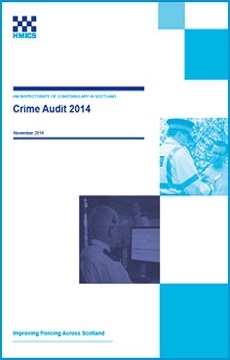The aim of our audit was to assess the state, efficiency and effectiveness of crime recording by Police Scotland and the extent to which recording practice complies with the Scottish Crime Recording Standard and the Scottish Government’s Counting Rules. The results of the audit will provide the public and key stakeholders with greater information on which to base their assessment of the accuracy of crime statistics and will highlight to Police Scotland areas of good practice as well as areas for improvement. Through our audit, we also sought to make a preliminary assessment of the extent to which Police Scotland has implemented previous HMICS recommendations in respect of crime recording. The audit also seeks to address the need for a comprehensive, independent audit of crime data as highlighted by the UK Statistics Authority.
In 2012-13, recorded crime in Scotland was at its lowest since 1974. At a time when the accuracy of statistics on recorded crime is increasingly being challenged in England and Wales, it is essential that the public in Scotland know whether they should have confidence in their own recorded crime statistics. Accurate crime data is also vital for the police service itself: it informs strategic planning and priority setting and allows the service to allocate resources where they are most needed.
Crime recording practice is governed by the Scottish Crime Recording Standard (SCRS) and the Scottish Government’s Counting Rules. The SCRS and the Counting Rules provide a framework for deciding when an incident should be recorded as a crime, what type of crime should be recorded and how many crimes should be counted. Crime recording should also be carried out in accordance with the Police Scotland Code of Ethics.
We tested the accuracy of crime recording through auditing incident and crime records. We examined over 8,000 incidents and over 4,500 crimes. While HMICS has conducted several audits of crime recording since the introduction of the SCRS in 2004, auditing this number of records allows us to report on statistically significant compliance rates across Scotland and, for the first time, at divisional level. This was a quantitative rather than qualitative study and this report focuses on the results of our audit, good practice and areas for improvement. However, we have also been able to draw key messages about crime recording against our inspection framework, focusing on the key areas of leadership and governance, and people. These and other aspects of our inspection framework will be explored in more depth in future reviews of incident and crime recording.
The number of records examined was more than five times higher than in previous audits. This placed demands on the service to accommodate our audit and we are grateful to the national and regional crime registrars in particular for facilitating our work.
Number | Recommendation |
|---|---|
1 | Police Scotland should develop a mechanism to ensure incidents referred to specialist investigation units are regularly updated as to the status of the investigation and are recorded as crimes as soon as it is appropriate to do so. |
2 | The Scottish Police Authority and Police Scotland should engage the Scottish Government and other stakeholders in exploring whether the crime groupings used for statistical purposes remain relevant taking account of the changing nature of crime. This should include consideration of whether the crime groupings reflect the public’s perception of crime. |
3 | Police Scotland should introduce processes, including appropriate supervision, to ensure that incidents are closed and disposed of correctly. |
4 | Police Scotland should ensure that, where relevant, complainers in cases where there has been a no-crime decision should be kept updated on the status of the investigation and its conclusion. |
5 | Police Scotland should develop improvement plans for crime recording practice in four local policing divisions: Renfrewshire and Inverclyde, Ayrshire, Edinburgh and Argyll and West Dunbartonshire. The plans should set out how each division will improve its compliance with the Scottish Crime Recording Standard and the Counting Rules. |
6 | The Scottish Police Authority’s Audit and Risk Committee should request from Police Scotland the full results of internal crime recording audits and should monitor the implementation of any resulting improvement actions. The Committee should also monitor improvement plans developed by Police Scotland in response to recommendations made about crime recording by HMICS. |
7 | Police Scotland should provide local scrutiny and engagement bodies with the findings of internal crime recording audits and any resulting improvement plans. This will facilitate the scrutiny of crime data presented to them by local commanders. |
8 | Police Scotland should work with the Scottish Government to clarify ownership of the Counting Rules. |


